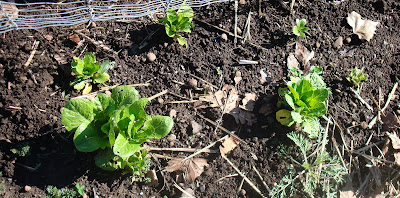Once again, I've managed to get really behind on my blogging. Sunday was another great Organic Gardening class. The GRUB folks spoke and we got a lot of good information. I've included a summary at the end.
Monday was rainy, but on Tuesday, I went over to the farm for a bit. I took pea seeds and stuff, but all I ended up doing was drinking beer. But it was nice to see that the daffodils have bloomed. In other blossoming notes, the quince has been blooming for at least two weeks, and by last week, the camillias were in full bloom. These are good harbingers of Februation.
These are some Green Towers romaine. I planted them in the fall, but it was too late and they never really took off. Still, they are growing and should provide lovely heads of lettuce soon.
These babies in pots will catch right up. These are Blushed Butter and Rouge Gren. I moved these starts to the cold frame. They aren't growing as fast as the ones still in the hot box but I need that space for germinating more.
These are Karen's fava bean on Tuesday. I brought them back for planting, because they gotta go in the ground soon!
It's time to pull the broccoli out, but there are still a few harvestable side shoots. We ate one with dinner last night and it was unbelievably sweet with a complex flavor
I've been making a sourdough starter, and I finally cooked some bread with it. It came out great! I was worried because I don't expect success the first time, but it was delicious. Again, a very complex flavor, and it was well leavened even though I used a lot of wheat flour (freshly milled from Massa Organics).
Here it is served with shrimp salad. We ate the same thing last night, but with a fresh fried egg instead of the shrimp, and lots of greens from the farm.
And...Rick says it's the cold weather that's keeping him away from the farm, but we know the real reason!
Ok now that we've had fun with pictures, here's the GRUB synopsis
The GRUB folks gave a very enlightening and information-dense presentation. I'll try to summarize.
Lettuce: October is the last lettuce planting, with planting resuming in January. They like Concept, Jerico, Lolo Rossa, and Lockhart. Red leaf loose lettuces are more cold tolerant.
Tomatoes: It's time to start them now. They stagger putting theirs out but admitted that the ones set out about Labor Day did the best. They recommend Big Beef and said don't get Red Ace. They set them 2 feet apart in rows set 3 feet apart, and water them for 5 drip hours every 5 days. They weave twine between stakes to hold them up.
Corn: They liked Sweet Chorus, a bicolor. Corn takes a lot of room.
Garlic needs side dressing with compost or foliar feeding.
Carrots: They use Scarlet Nantes carrots in the fall, and Mokum, which is a quick, 50-day carrot, in the spring along with the Nantes, which gives them a staggered harvest.
Peppers: They use pole beans for shade to keep their peppers from getting sunscald. They like Valencia (an orange bell), red marconi, and quadrati asti giallo. They don't fertilize until the peppers fruit. Otherwise you just get too much vegetation. But after fruiting, you can encourage the extra leaf growth with nitrogen to also help cover them from sunscald.
Potatoes can go in March 15. Don't use compost! But they cut them to one to three eyes, and then coat them with gypsum. This seals the wound, and they plant the next day. Don't use supermarket potatoes. C-Bar-D has baby potatoes in stock now.
Fall Crops: They had good luck with Romanesco Veronica and grew huge cauliflowers.
Fertility: They use organic inputs like Cal Organics 7-5-7 granular fertilizer, plus kelp meal and compost teas. They also use cover cropping, and they explained that you don't want to let your cover crops go to seed, not only to avoid weeds but to retain the nitrogen in the soil, which would otherwise go to seed production. They mow the cover crop, then till it in and leave it for 2 weeks in summer, 4 weeks in fall to allow the stems to compost. They are beginning to experiment with foliar feeding.
Seeds: They get their seeds from Fetco and Totally Tomato, among others.
Watering: They use all drip and run them for many hours per day, from 5 hours every 5 days for tomatoes, to 3 hours every other day for carrots. They water in the heat of the day to cool the soil.








No comments:
Post a Comment